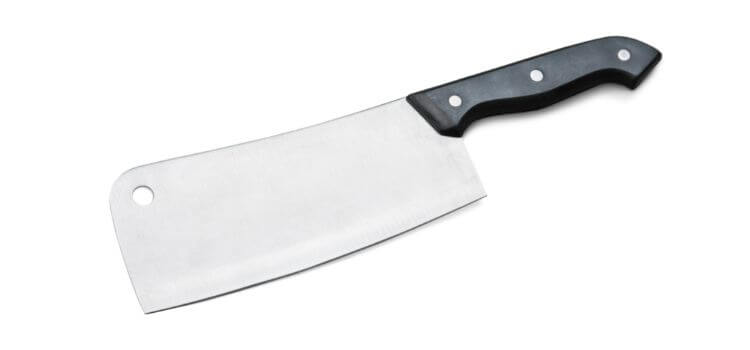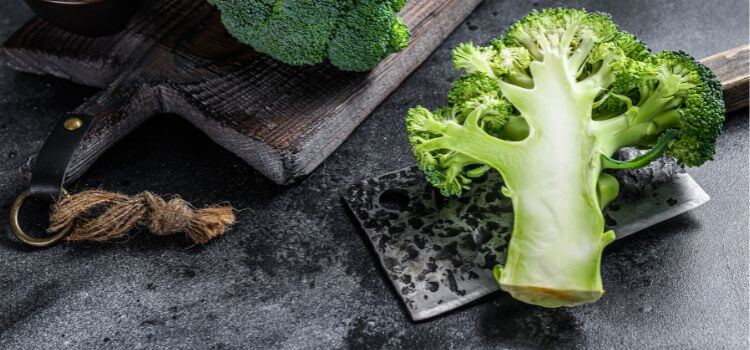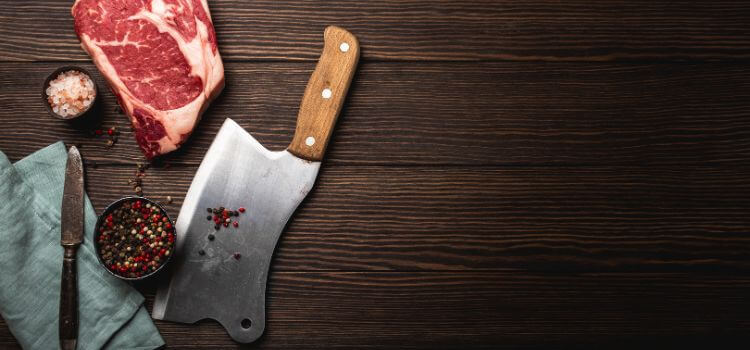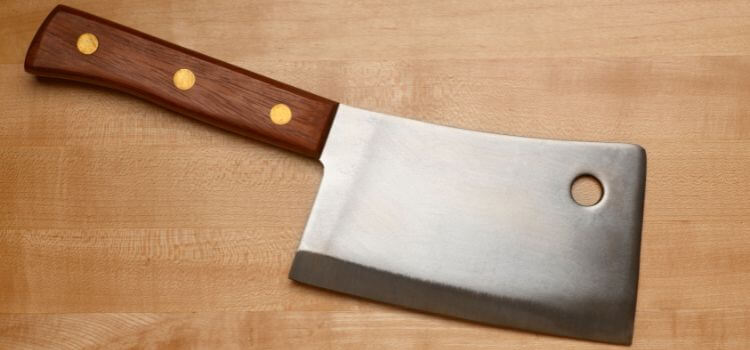As an Amazon Associate, I earn from qualifying purchases

In the culinary world, choosing between a vegetable cleaver and a meat cleaver can significantly impact the efficiency and precision of your kitchen tasks. These two essential tools each have distinct characteristics and purposes that cater to specific cutting needs.
Exploring the differences between a vegetable cleaver and a meat cleaver unveils a realm of nuances that can elevate your cooking experience to new heights. Let’s delve into the unique traits of these cleavers to understand when and how to wield them effectively in the kitchen.
Understanding the Vegetable Cleaver

A vegetable cleaver, also known as a Chinese chef’s knife or chopper, features a wide, rectangular blade complemented by a gently curved edge. The design of the vegetable cleaver is intended for chopping, slicing, and mincing vegetables effortlessly.
The blade of the vegetable cleaver is typically thinner and lighter than a meat cleaver’s. This feature allows for quick and precise movements, making it ideal for handling delicate vegetables.
The sharp tip of the vegetable cleaver can also be used to pierce through tougher vegetables like squash or root vegetables. This versatility makes it a popular choice among chefs for various kitchen tasks.
Primary uses of a vegetable cleaver
- Chopping and slicing vegetables: The wide blade of the vegetable cleaver allows for efficient chopping and slicing of vegetables with a single downward motion.
- Mincing herbs and garlic: The sharp edge of the vegetable cleaver makes it easier to crush and mince small ingredients like herbs and garlic.
- Preparing meat: Although a vegetable cleaver primarily uses vegetables, it can also be used to prepare meat by cutting through small bones and cartilage.
- Smashing food items: The flat side of the vegetable cleaver can be used to smash food items like garlic or ginger, releasing their flavors more effectively.
Key Statistics of the Vegetable Cleaver
- Blade length usually 6-8 inches
- Blade thickness is less than 3mm
- Medium weight, usually around 200-300 grams
- Typically between 15-20 degree cutting angle
Benefits of using a vegetable cleaver
- Fast and efficient: The broad blade and sharp edge of the vegetable cleaver allow for quick and precise cuts, making it an ideal tool for preparing vegetables in large quantities.
- Versatility: A vegetable cleaver is versatile, adept at slicing through everything from delicate herbs to robust root vegetables.
- Comfortable grip: The rectangular shape of the vegetable cleaver’s handle provides a comfortable grip, reducing hand fatigue during extended use.
Understanding the Meat Cleaver

A meat cleaver, also known as a butcher’s knife, is a heavy-duty blade with a thick spine and a large, rectangular shape. It has a weightier feel compared to the vegetable cleaver, making it ideal for cutting through dense meats like beef or pork.
The thick spine of the meat cleaver allows for more forceful chopping motions without damaging the blade. This feature is crucial when dealing with tougher cuts of meat that require more strength to cut through.
Primary uses of a meat cleaver
- Breaking down large cuts of meat: The weight and sturdy design of the meat cleaver make it perfect for breaking down larger pieces of meat into smaller, more manageable portions.
- Cutting through bones: A meat cleaver’s thick spine and weight make it the ideal tool for cutting through bones.
- Tenderizing meat: The flat side of the meat cleaver can be used to tenderize tough cuts of meat, making them more tender and easier to cook.
Key statistics of vegetable and meat cleaver
- Blade length usually 7-9 inches
- Blade thickness is between 3mm-6mm
- Weight is usually around 500 grams or more
- Typically between 20-30 degree cutting angle
Benefits of using a meat cleaver
- Efficient slicing and chopping: The weight and design of a meat cleaver make it perfect for quick and precise slicing and chopping of large cuts of meat.
- Durable and long-lasting: A meat cleaver’s thick, sturdy design makes it a durable tool that can withstand heavy use without losing its sharpness.
- Versatile cutting abilities: While primarily used for meat, a meat cleaver can also handle other kitchen tasks like crushing garlic or slicing through thick-skinned fruits and vegetables.
A Comparison: Vegetable Cleaver vs Meat Cleaver

Key statistics of vegetable and meat cleaver:
Cleaver | Vegetable | Meat |
Blade Length: | 6-8 inch | 7-9 inch |
Blade Thickness: | Thin, usually less than 3mm | Thick, between 3mm-6mm |
Weight: | 200-300 Grams | 500 Grams or more |
Cutting Angle: | 15-20 Degrees | 20-30 Degrees |
Blade design
The most significant difference between a vegetable cleaver and a meat cleaver lies in their blade design. A vegetable cleaver’s blade is thinner, lighter, and has a sharper edge compared to a meat cleaver’s thick, heavy-duty blade.
The thin blade of the vegetable cleaver allows for more delicate cutting movements and precision, while the thicker blade of the meat cleaver can withstand more forceful chopping motions.
Thickness and weight
As mentioned, the vegetable cleaver is lighter and more delicate than the meat cleaver, which has a weightier feel. This difference in weight and thickness is due to their intended purposes.
A vegetable cleaver’s main use is for slicing and chopping through vegetables with precision. In contrast, a meat cleaver’s thicker blade and heavier weight are necessary for handling tougher meats and bones.
Usage Scenarios Of Vegetable and Meat Cleaver
- A vegetable cleaver is best used to chop delicate vegetables, herbs, and fruits.
- When handling large cuts of meat or slicing through bones, opt for a meat cleaver for efficiency and precision.
- For tasks that require more precision, such as mincing garlic or peeling fruits, the lighter and thinner blade of a vegetable cleaver would be the better choice.
- A vegetable cleaver is perfect for preparing stir-fry dishes, as it can quickly and efficiently slice through various vegetables without crushing them.
- The weight and force of a meat cleaver make it ideal for cutting through tough meats like beef or pork, making it the go-to tool for dishes like steak or ribs.
- When preparing a dish with meat and vegetables, use a vegetable cleaver for handling the vegetables and a meat cleaver for the meat to ensure optimal results.
Maintenance and Care
- Cleaning: Following each use, cleanse the cleaver using warm, soapy water and ensure it is completely dried. Avoid harsh abrasives or dishwashers, which can dull the blade’s edge.
- Sharpening: Use a sharpening stone or honing rod to maintain the sharpness of your cleavers. Sharpen them regularly to ensure optimal performance.
- Storing: Keep your cleavers secured in a knife block or sheath to safeguard the blades and minimize the risk of accidents. Avoid storing them loosely in drawers, as this can lead to dulling and damage to the blades.
- Maintenance: Regularly oil your cleavers with food-grade mineral oil to prevent rust and maintain longevity.
Conclusion
In summary, vegetable and meat cleaver are essential tools for any kitchen. They have distinct designs and uses that make them valuable additions to your cooking arsenal. By understanding their differences and how to use and care for them, you can easily elevate your culinary skills and create delicious meals.
So, whether mincing herbs or breaking down a whole chicken, having both a vegetable cleaver and a meat cleaver on hand will make your cooking experience more efficient and enjoyable. Happy chopping!
As an Amazon Associate, I earn from qualifying purchases
Pingback: Bread Machine vs Stand Mixer: Which is Right for You?